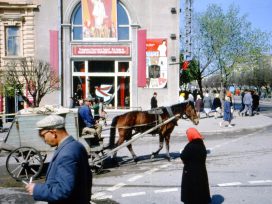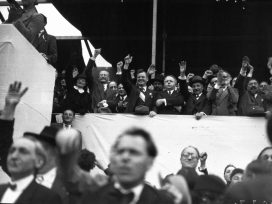In order to tackle the historical origins of anti-Catalanism, it is first necessary to outline a number of conceptual elements. If we are to understand Catalanism in a strict sense, assimilating it into contemporary Catalan nationalism, it will be necessary to place the origins of anti-Catalanism in the mid-nineteenth century. On the other hand, if we consider anti-Catalanism as a feeling and an expression, above all political, one that is opposed to an idea of a Catalan nation made up of the “Catalans”, we shall have to go back to the time of the formation of the original state and national structures, in other words, the Late Middle Ages and the Renaissance.
When and why did anti-Catalan feeling and thinking emerge? For Francesc Ferrer, who defined it as “Catalanophobia”, it began in the time of the Count-Duke of Olivares. However it is not difficult to find testimonies that show that anti-Catalan feeling had become established in Castile long before that. In 1534, Estefania de Requesens wrote to her mother, the Countess of Palamós, that her son Lluís – the future governor of Milan and the Low Countries – was defending the good name of Catalonia from the attacks of the other pages at the court:
Lluïset kisses your ladyship’s hands and says he will study a lot […] and that he wants to be Catalan; that he is already defending the land against the other pages of the prince who say bad things about Catalonia.
The episode Estefania de Requesens referred to about took place at the Castilian court; like in the texts and testimonies produced by Francesc Ferrer and other authors, it refers to an anti-Catalan feeling projected from and rooted in Castilian Spain. But when and why had this feeling come about? Did anti-Catalanism originate in other regions?
To tackle these questions, it is necessary to outline the origins of national identities and counter-identities. In western Europe, the Late Middle Ages and the Renaissance were key moments in the emergence of new national identities. It is a historical “moment” when politico-territorial definition, institutional development, a nation’s own legal framework, written vernacular language, historical awareness, and shared feelings and symbols were combined in different communities in western Europe. These identities would take shape, in the perception of the old Universitas Cristiana, through contacts and relations promoted by elements as diverse as wars, the expansion of trade, the tales of travellers, or the greater circulation of books and news after the invention of the printing press. The term nation retains in this period its traditional meaning as language community. However it is not always used as such; like the concept patria, with which it is often confused, “nation” tends to take on political and territorial connotations.
A “national feeling” can be observed that is not content just to distinguish “native” from “foreign”, but that exalts the former and denigrates the latter, and therefore shapes feelings of counter-identity and aversion to stereotyped “others”. Erasmus of Rotterdam clearly perceived that patriotic-national identities had a highly emotional basis; in his Colloquies, the “Prince of Humanists” declared:
[…] virtually all the Anglo-Saxons hate the Gauls and all the Gauls hate the Anglo-Saxons, just for being so. The Irish, for being so, hate the Bretons, the Italians the Germans, the Swabians the Swiss, and so on.
Within the historical “moment” in which national identities take on meaning and definition among other things via the counter-identities they generate, I shall distinguish four stages in the shaping of anti-Catalanism in the late mediaeval and modern periods.
1
The first phase corresponds to the two hundred years between the end of the thirteenth century and the end of the fifteenth century. This was when these national identities and counter-identities were originally shaped. In this period, I believe that the Castilianism and anti-Catalanism that in later centuries showed itself so vigorously was only in a latent state. The formulation of an imperial Castilian idea over the Hispanic ambit by chroniclers such as Rodrigo Ximénez de Rada, or later the conversos Pablo de Santamaría and Alfonso de Cartagena, did not conflict with Catalan historical-legendary thinking due to the isolation of both cultural traditions. The idea that the Kings of Castile were the only legitimate descendants of the Gothic monarchs, that the foundation of civilization and Christianity in the Peninsula began in Castile, or that the hegemony of the Castilian dynasty in the Hispanic ambit was undisputable and a result of the designs of Providence, were developed in parallel, but not in polemical confrontation, with the history of Catalonia and its institutions being written by the great mediaeval chroniclers and jurists Bernat Desclot, Ramon Muntaner or Jaume Marquilles, among others. These authors championed a form of government based on the combination of the principles of freedom and law and order; like the Castilian intellectuals, they understood their own historical process as a succession of events governed by Providence. However, these cultural traditions developed in isolation, without clashing.
In this period, however, expressions of anti-Catalanism can be found in Italy and Aragon. The Catalan military expansion in Sicily, Sardinia, and the south of the transalpine peninsula, accompanied by the penetration of Catalan merchants into these markets, generated a deep feeling of antagonism towards the Catalans – often identified as Spanish. This was an anti-Catalanism that can be found in the works of Dante Alighieri, Giovanni Boccaccio, Francesco Petrarca, Luigi Alamanni, Pietro Aretino, Serafino Aquilano, and so on. It was an anti-Catalanism that was more cultural-linguistic than politico-territorial; this is reflected in the generalized protests over the election of Alfonso de Borja in 1455 as Pope Callistus III for being barbaro e catalano.
Internal tensions within the Catalan-Aragonese court led to an anti-Catalanism being projected from Aragon; this was directed specifically against the Principality of Catalonia, and therefore had a greater politico-territorial component. The chronicler and Cistercian monk Fabricio de Vagad showed himself, in his Crónica de Aragón (1499), to be a zealous Aragonese patriot defending its furs (rights) and privileges, but also as a fierce critic of Castilians and Catalans.
2
A second phase of anti-Catalanism went from the end of the fifteenth century to the end of the sixteenth century. It was a period marked by two phenomena that had an impact on the growth of Castilian anti-Catalanism. First, the invention of the printing press, which subsequently enabled Castilian ideas of hegemony to be spread all over Europe by way of the Latin language. This unleashed the clash between the different conceptions of Spain contained in the Catalan-Aragonese and Castilian cultural traditions. The Castilian claim to hegemony provoked a polemical response from Catalan humanists facing the “loss of reputation” it meant for their patria and their own historical tradition. The second phenomenon was the process of dynastic union, whereby Catalonia was incorporated into the Catholic and then the Habsburg monarchies; here, Castile indisputably exercised the role of pivot and federal centre.
The first “Spanish history” to reach the presses was the Compendiosa Historia Hispanica by Rodrigo Sánchez de Arévalo, printed in Rome in 1470, probably by Ulrich Hahn. Rodrigo Sánchez de Arévalo, ambassador to Rome of John II and Henry IV, insisted on the idea of Castilian pre-eminence, glorifying Castile’s divine mission in a way even more inflated and pretentious than Ximénez de Rada or Alfonso de Cartagena. The idea that Spain was a single historical community runs strongly through Castilian historical thinking in the sixteenth century (Florián de Ocampo, Pedro de Mexia, Pedro de Medina, Juan Sedeño, etc.); at the same time, a supremacist and assimilatory Castilian ideal is reinforced. In these battles for pre-eminence, anti-Catalanism is present by default, as contempt for the Catalan language, history, laws, and customs. These remain blurred and even buried by the Castilian Spanish hegemonic concept, a fact that earned the irate denunciation of the Tortosan Cristòfor Despuig in Els Colloquis de la insigne ciutat de Tortosa:
[…] for they wish to be so absolute, to have what is their own so much and what is foreign so little, that in their opinion they alone come from heaven, while the rest of mankind has come from the earth.
To understand the second key factor in the growth of Castilian anti-Catalanism, it is necessary to consider that Castilian centrality placed the territories on the periphery of the realm under a double yoke: that of the Crown and that of a central government that, based in Madrid, was predominantly controlled by Castilian politicians. The political-institutional tensions resulting from this situation fanned anti-Castilian and anti-Catalan feelings. These reactionary identities exploded in places where Castilians and Catalans came into contact: in the fortresses on the frontier of Roussillon with Castilian garrisons, on the highways and byways of the Principality of Catalonia, where these soldiers moved, in the court of the monarchy, or in the monasteries like Montserrat, where the coexistence between Catalan and Castilian monks was full of hostilities. Here we find a more political-national anti-Catalanism, directed especially towards the natives of Catalonia and less to do with the Catalan-speaking “nation”.
3
In the closing stages of the sixteenth century, anti-Catalanism intensified, especially among government circles and the royal administration. From hereon, we can distinguish a third phase that would last until the Catalan revolution of 1640. Beginning in the last decades of the reign of Philip II, the Castilian court intelligentsia developed the idea of Spain as a political community. This would constitute an average state that was territorially compact and equipped with common cultural and historical links – political ideals that were accompanied by a strong feeling of Spanish patriotism. From this moment on, proposals for institutional, fiscal, and legislative unification began to be drawn up; these had a strong Castilian bias and, deep down, were closer to a proposal for annexation and assimilation rather than integration. They met strong resistance in Catalonia and, in general, in the countries of the Crown of Aragon.
As the seventeenth century advanced, for many members of the court and government circles, the “Spanish fatherland” was added to the values of God and King. In the eyes of many of these intellectuals and leaders, the institutional organization of the Principality of Catalonia and, in general, its socio-political and fiscal organization, had to be adapted to the pre-eminence of these values. A scale of loyalties, however, that was not the same as that which had developed in Catalan society.
Alongside these ideological controversies, thought at times closely linked to them, we witness a rise in constitutional tensions. The disturbances of 1585-93 were a moment of “political breakdown” between Catalan institutions and the central government of the monarchy, placing the political dialectic on the slope towards the revolution of 1640.
These tensions, especially in the court in Madrid, caused an underlying anti-Catalanism, by now fully to do with politics and identity, to take root. Even Miquel Joan Magarola, for many years governor of the Council of Aragon and from August 1639 governor of the Royal Chancellery of the Principality of Catalonia, a loyal royalist supporter very familiar with the Madrid court, expressed to the viceroy, the Count of Santa Coloma, the opinion that the lack of support experienced by the Castilian troops in Roussillon was due to the antagonism of the court circles towards the Catalans:
I see […] the aversion that these people feel for our nation, which is great and felt every day, and I think and suspect that they will do no good on the subject of money […] anyway, my Lord, I don’t know what to think, but that they are our enemies, it is a shame how the Catalans are treated.”
It seems that anti-Catalan hostility had passed through the walls of the palaces of the court and had spread among the people. After the loss of the fortress of Salses, in August 1639, another Catalan living in Madrid, Fructuós Piqué, confessed to an official of the viceroy that the Catalans were terrified and did not dare go out on the streets, “in fear of the boys stoning us if they get a whiff of what we are”.
4
The fourth stage covers the period from 1640 to 1714. With the outbreak of the Revolution of 1640, the alliance of Catalonia with France, and the war of separation from the Spanish monarchy, another phase of Castilian-Spanish anti-Catalanism began. It was characterized not only by increased intensity but by its prevalence among the Castilian population, by its clear national-territorial dimension, and by its projection especially towards the Principality of Catalonia.
For the Castilian ruling classes, the process of separation of Catalonia from the Spanish monarchy opened up a bottomless pit of spite and suspicion towards the Catalans. The fighting that broke out in 1640 brought, directly and massively, “Castilians” and “Catalans” into conflict with one another. The war unleashed a spiral of unstoppable hatred. When the troops of the army of the Marquis of Los Vélez approached Barcelona in January 1641, the Catalans attacked the soldiers, from the mountains of the Llobregat, to the cry of “flesh, Castilian flesh”, while the Castilian troops attacked Montjuïc on the later that month, “to a huge cry of ‘Viva España'”. The propaganda workshops on both sides amplified and spread anything that contributed to increasing the separation and the antagonism towards the “enemy nation”, giving strength and volume to the feeling of counter-identity. In the Castile of the mid-seventeenth century, the image of the Catalans as a disloyal enemy, as ungovernable, as a people that had betrayed the common project of the Spanish nation, for which the only solution was subjection by force, was consolidated. An anonymous Manifiesto por las armas de Philipo Quarto el Grande en Cataluña y compendio de sus sucesos en el año de 1640, which circulated handwritten around Madrid in those years, perfectly reflects the dimensions that this anti-Catalan feeling had reached:
They are ungrateful for everything, never sure; if you put up with them, they get bolder; if you wait for them, they go wild; if you forgive them, they settle down; if you put pressure on them, they get annoyed; so that there is no way, by leaving them in their freedom, that they will not get worse. And they are in need of the majesty of the most benign monarch, who after so many centuries, from predecessor to predecessor, should today lay down in this Principality, the law, the yoke and justice.
The “return” of 1652 was marked by mutual repression and distrust. Not even the military and monetary services that the Catalans provided during the reign of Charles II in the wars against Louis XIV’s France served to rebuild links of political trust that the war of secession of 1640-1652 had broken completely. As the anonymous author of Luz de la verdad expressed, in 1699, from the mouth of the Catalan soldier Joan Roca: the events of the Reapers’ War were the main cause of “the opposition that the Castilians have for us”.
As a peninsular civil war, the War of Spanish Succession was pervaded with “national” hostilities. Catalan society’s anti-Castilianism had its correlation in the anti-Catalanism of the Castilians. The felipista soldier and chronicler Vicente Bacallar de Sanna explained the Castilian people’s determined defence of the Bourbon cause, saying that
[…] it cannot be denied that the spirits of the Castilians were greatly sustained by the natural vanity of not being conquered by the Aragonese and Catalans, and offended by the Portuguese, whom they abhorred and despised.
The account of Narcís Feliu de la Penya told of the fear and hostility of the people of Madrid towards the Catalan Miquelets accompanying King Charles in 1706. According to Feliu, in order to maintain order in the Castilian capital, some troops were ordered to
[…] dress the same way as the Miqueletes of Catalonia, as the people of Madrid had great terror of the Miqueletes, the generals judging, that, just with the name and the clothes, a few would be arrested.
The war served to spread anti-Catalan feelings even more among the body of Castilian society. Bu in the governing and leading circles of the Spanish nation-state, the feeling was so deep that it had an ethnic dimension more than just a political one.
After 1714, the Bourbon repression was deliberate, systematic and violent. Aside from giving free rein to an undisguised desire for revenge, it pursued a quite specific political objective: to apply an exemplary punishment in order to ensure the total subordination of the province where the “crime of rebellion” was “native”. In the words of the Captain General, the Marquis of Castel Rodrigo, only with the medicine of arms and power could
[…] their blood be cleansed completely of the evil that infects it, or at least purged; so that with the passage of time and the continuous application of efficient remedies, there is a hope of health […] for the bad humour of these natives can be contained by arms, but can never be eradicated with just their force.
In the eyes of the Bourbon authorities, armed force was not enough to put an end to the “disease” of that province. They had to liquidate its identity as a community, as a nation: “Wiping from the memory of the Catalans all that may conform to their abolished constitutions, ussáticos, fueros, and customs”, as the members of the Council of Castile declared in June 1715.
Even the Catalans, who had demonstrated a fervent felipisme, were not free of suspicion of the national feeling that had to be eradicated. The instructions received by the Marquis of Castel Rodrigo when he was appointed Captain General of the Principality of Catalonia, read:
[…] given the Catalan nation is of such bad quality, that even with the best of them, who have shown themselves to be the finest, it is better to take greater care, without giving them room to manoeuvre in their own country”.
Such warnings that had to be amplified in the case of the Catalans serving in the army:
[…] these are good and we have experience of their loyalty; nevertheless, their love for their fatherland, and for its fueros, is nevertheless so great and blind, that their constant zeal, which up to now the good ones have shown in royal service, could be a threat, and to avoid this risk, it would be convenient to deploy them in other parts outside the Province.






